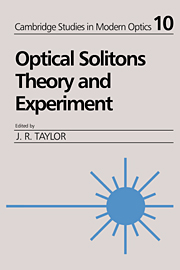Book contents
- Frontmatter
- Contents
- List of contributors
- Preface
- 1 Optical solitons in fibers: theoretical review
- 2 Solitons in optical fibers: an experimental account
- 3 All-optical long-distance soliton-based transmission systems
- 4 Non-linear propagation effects in optical fibres: numerical studies
- 5 Soliton–soliton interactions
- 6 Soliton amplification in erbium-doped fiber amplifiers and its application to soliton communication
- 7 Non-linear transformation of laser radiation and generation of Raman solitons in optical fibers
- 8 Generation and compression of femtosecond solitons in optical fibers
- 9 Optical fiber solitons in the presence of higher-order dispersion and birefringence
- 10 Dark optical solitons
- 11 Soliton-Raman effects
- Index
6 - Soliton amplification in erbium-doped fiber amplifiers and its application to soliton communication
Published online by Cambridge University Press: 21 October 2009
- Frontmatter
- Contents
- List of contributors
- Preface
- 1 Optical solitons in fibers: theoretical review
- 2 Solitons in optical fibers: an experimental account
- 3 All-optical long-distance soliton-based transmission systems
- 4 Non-linear propagation effects in optical fibres: numerical studies
- 5 Soliton–soliton interactions
- 6 Soliton amplification in erbium-doped fiber amplifiers and its application to soliton communication
- 7 Non-linear transformation of laser radiation and generation of Raman solitons in optical fibers
- 8 Generation and compression of femtosecond solitons in optical fibers
- 9 Optical fiber solitons in the presence of higher-order dispersion and birefringence
- 10 Dark optical solitons
- 11 Soliton-Raman effects
- Index
Summary
In this chapter, soliton amplification and transmission using erbium-doped fiber amplifiers are presented. First, the general features of the erbium-doped fiber amplifier are described. A new method called dynamic soliton communication is presented, in which optical solitons can be successfully amplified and transmitted over an ultralong dispersion-shifted fiber by using the dynamic range of N = 1–2 solitons. Multi-wavelength optical solitons at wavelengths of 1.535 and 1.552 μm have been amplified and transmitted simultaneously over 30 km with an erbium-doped fiber repeater. It is shown that there is saturation-induced cross talk between multi-channel solitons, and the cross talk (the gain decrease) is determined by the average input power in high bit-rate transmission systems.
The amplification of pico, subpico and femtosecond solitons and 6–24 GHz soliton pulse generation with erbium-doped fiber are also described, which indicates that erbium fibers are very advantageous for short pulse soliton communication. Some soliton amplification characteristics in an ultralong distributed erbium fiber amplifier are also presented. Finally, we describe 5–10 Gbit/s transmission over 400 km in a soliton communication system using the erbium amplifiers.
Introduction
Recent progress on erbium-doped fiber amplifiers (EDFA) has been very rapid since they show great potential for opening a new field in high-speed optical communication (Mears et al., 1985; Poole et al., 1985; Desurvire et al., 1987; Snitzer et al., 1988; Kimura et al., 1989; Suzuki et al., 1989; Nakazawa et al., 1989).
- Type
- Chapter
- Information
- Optical SolitonsTheory and Experiment, pp. 152 - 196Publisher: Cambridge University PressPrint publication year: 1992



